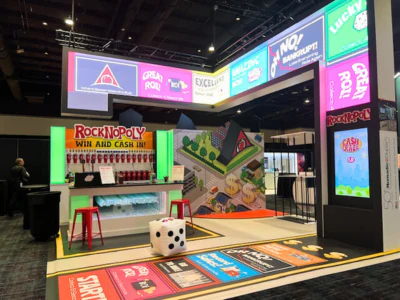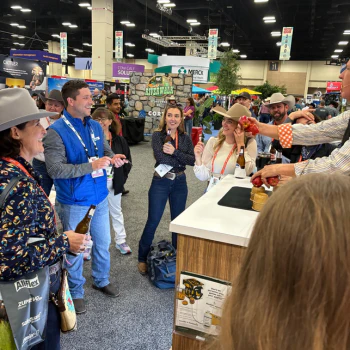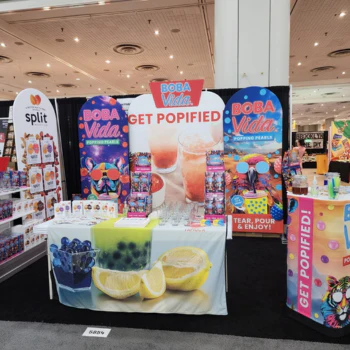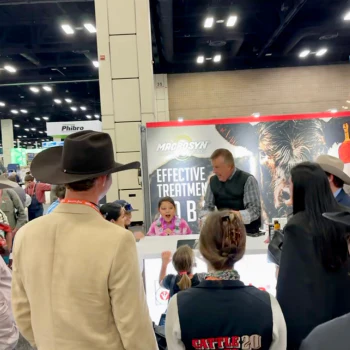فهرست مطالب
- 1 There is no substitute for physical contact.
- 2 Give people a taste of the exhibition and booth
- 3 Give people the product to try: Let them use the product, not just hear about it.
- 4 Take care of your good deeds: Transparency builds trust.
- 5 Hire a professional exhibitor
- 6 Create something with the help of people: Co-creation = Connection
- 7 Interact with people.
Booth Design and Decoration System – One of the common mistakes at many trade shows is the inability to answer this key question: “What is our goal when people enter our booth?” This seemingly simple question will actually have a profound impact on the success or failure of your show.
When a visitor enters your space, they are actually looking for an attraction and connection that can attract them. The most important thing is that this moment is very fast and fleeting. And unfortunately, most exhibitions lose their ability to attract the visitor’s attention at first glance.
Even though your booth may be professionally designed and beautifully lit , if there is no interaction or activity, visitors will quickly leave. In other words, there is no clear reason to stop, stay, or explore your space further.
This problem is not limited to booth design , but is a strategic flaw. The best exhibitions are not limited to aesthetic beauty; they create activity and interaction. These spaces invite people to participate and explore in a human and meaningful way, without feeling pressured or imposed.
Today, engagement is more important than ever. We are designing for a very selective audience. People are used to ignoring advertising and skipping through the noise. So if your booth is passive or even forgettable, it will likely be ignored.
The good news is that you don’t need a big, sprawling space; you just need to do the right things. What’s really needed is intention. You need to have a clear goal of what you want visitors to do in the space, what they see, what they feel, and what they create. This engagement doesn’t necessarily mean using technology or playing fun games; it needs to be based on real participation.
Below are six practical and effective ways to create this type of interaction, based on real-life behavior and reactions at today’s trade shows.
There is no substitute for physical contact.
Physical contact is a key component of the user experience that nothing can replace. Let participants have real interaction with your products. Encourage them to touch the product, turn it around, and feel its texture. Let them test the weight of the product, squeeze it, fold it, and pull it. This type of interaction will not only enrich their experience, but also allow them to form a deeper connection with the product.
If your product is well-designed and built, it’s best to offer it directly to customers. If your product is a service or an abstract concept, try creating a tactile demo that can clearly demonstrate the concept and create a more tangible experience.
Even brands that are digital-first can benefit from simple analog experiences. For example, using puzzle cubes or textured panels can spark curiosity and improve communication. Nothing increases the power of conversation and exchange like a hands-on experience.
If you find yourself saying, “This product is more powerful than it looks,” it’s time to let your visitors experience it for themselves and gain a deeper understanding of the value of your product. Let them discover for themselves what the product is truly capable of, because that kind of experience will be far more impactful than any verbal explanation.
Give people a taste of the exhibition and booth
If you’re in the food, beverage, hospitality, or lifestyle industries, now is a great time to tap into the sense of taste. But instead of using the traditional, soulless approach of putting out a bowl full of candy, you should think about creating meaningful experiences that tie taste to your brand message, product use, or visitor journey to create an unforgettable experience.
Creative brands have figured out how to match flavor profiles to buyer personas. For example, they use small samples to guide visitors to product demos and even set up scent-based tasting stations to trigger memory and conversation. These methods help visitors have a multisensory experience, making those experiences more memorable.
These experiences don’t need to be elaborate or expensive, but they should convey the sense that you’re using your sense of taste intentionally and purposefully. The taste should be designed with specific, interesting details to be effective.
Furthermore, one of the main advantages of using the sense of smell is that scent easily transcends any object. People usually go for the scent before they read a banner or advertisement. The trick is to leverage this sense to provide an unforgettable experience that will draw attendees to your brand and encourage them to talk more about your products.
Give people the product to try: Let them use the product, not just hear about it.
The experiences people have with your products play a huge role in building their connection and understanding of your brand’s value. Demos are one thing, but providing a real test of your product is something entirely different and more impactful.
If your product is software, provide an opportunity for visitors to try it out for themselves; let them click on it and experience its various features. If your product is physical, let them assemble a piece of it or test out a specific feature. Creating a “Try It Yourself!” station can create an engaging and memorable experience for visitors.
Even if your services aren’t naturally subject to in-person testing, you can create a tangible, hands-on experience by simulating them. You can design quizzes, provide short guides, or create scenarios that force visitors to interact and provide a close-to-life experience. Anything that can change the dynamic and give visitors the opportunity to take control of the experience will be very effective.
When people directly discover the value of your offering, they are more likely to believe it and be more willing to use it. For example, at a recent trade show, a client turned the mobile registration process into a game. In this experience, the demo became a conversation, and visitors walked away from the show knowing how fast and simple the process was, without the need for a special presentation.
These types of experiences are not only memorable, but they also help to imprint your brand in the minds of your audience, encouraging them to use your products or services in the future.
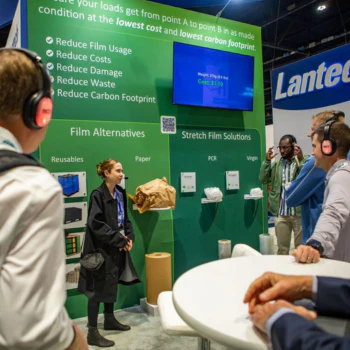
Take care of your good deeds: Transparency builds trust.
Sometimes, visitors just want to see how your product works. Giving them this opportunity can go a long way in building trust and confidence in your brand.
Live product builds, walkthroughs, and behind-the-scenes looks at your processes and team can be very effective. These types of activities may not be glamorous, but they are transparent and real. These methods make people feel like your team is approachable and your product is trustworthy.
This kind of transparency can also encourage better questions from visitors. When visitors watch your team assemble or disassemble a product, they will have more trust in you, especially compared to someone just showing off in the corner with an iPad.
Even if you don’t plan on fully opening the product, offering a simple screen reset halfway through the day can be a sign of your confidence. This action not only makes visitors feel confident and in control of your work, but also encourages them to engage more.
In general, you don’t need to be flashy or overly complex; just be clear and show visitors how your product works. This kind of simple, honest communication can build trust with your audience and encourage them to become loyal customers.
Hire a professional exhibitor
The idea of hiring a “booth man” may seem outdated, and if not done properly, it can actually look old-fashioned and out of place. But the real point here is not the action, but the personality and capabilities of the person themselves.
Rather than relying solely on text and headset presenters, think of this role as a conversation catalyst. Someone who can scan the aisle, look people in the eye, smile, and say, “Hey – want to see how this works?” These types of interactions can create a sense of intimacy and connection with visitors.
You don’t need elaborate staging, but someone with positive energy, empathy, and good timing. Some companies use brand ambassadors, while others use real team members with the right vibe. Some companies may also hire trained hosts who are well-motivated, rather than simply pre-planned.
These types of aggregators still work, but their success depends on featuring real people, not just paid actors. Authentic, intimate connections can help create positive experiences for visitors and make your brand more memorable. So focus on hiring people who can connect and create meaningful conversations so you can gain the attention and trust of your visitors.


Create something with the help of people: Co-creation = Connection
Nothing is more lasting than collaboration. When visitors help shape, build, or personalize part of an experience, a small but real connection to your brand is made that can have a profound impact on them.
Some of the ways we’ve seen this type of collaboration work well include:
Create content on a shared board : You can use a board or wall for writing or drawing that gradually evolves throughout the exhibition and people can share their ideas and creativity on it.
Live Polls : You can ask visitors to vote in a live poll and display the results instantly. This not only increases their engagement but also makes them feel like their opinions matter.
Content Personalization : Offering gifts or tailored content that is customized based on visitors’ needs and interests can create a deeper bond.
Share ideas digitally : Creating a space for visitors to share their ideas or feedback digitally and be sure to follow up on it can help create a two-way connection.
One of the simplest and most engaging examples is to create a wall where attendees can share their “must-haves” using Sharpies. This wall can act as a magnet at its best, getting others to stop, read, and write. It’s easy and effortless to manage, but it can draw crowds all day long.
Ultimately, the more people who are involved in shaping something with you, the more likely they are to remember you and your brand. This type of collaboration and engagement can be key to building deep and lasting relationships with your audience.
Interact with people.
This article examines the experience of designing and implementing an exhibition at ExhibitorLIVE 2025. The main goal of the exhibition was to encourage visitors to interact with the exhibition space, staff, and participating brands. Using creative strategies and purposeful designs, an attempt was made to attract positive feedback and greater participation from visitors.
Exhibiting at exhibitions as an effective marketing tool requires creating an environment that encourages visitors to engage. This research explores ways that can help increase engagement at exhibitions and illustrates the results through a specific experience at ExhibitorLIVE 2025.
Design and strategy:
From the moment visitors entered the exhibition space, they were greeted by a custom-designed game path called RockNoPoLY. The path included challenges that encouraged visitors to respond to brand topics in a fun and engaging way. In addition, interactive functions such as rolling dice and gaining seconds for competitions added to the appeal of the space.
Implementing Interactions:
Participants could roll dice to earn time, which was used in the Cash Craze kiosk, a touch-based game. The game was dedicated to collecting virtual money , which was eventually exchanged for promotional gifts, food, and drinks . This interactive model significantly facilitated real-world conversations and connections.
Related spaces:
To support further discussions, a relaxed seating area was created so that visitors could discuss their needs face-to-face. Also, an interesting photography section titled “City Prison” was added to the exhibition space, which led to the creation of fascinating memories for visitors.
Visual design and attention-grabbing:
A dynamic digital banner was installed above the display, displaying engaging messages from a height of 20 feet. This visual element was significantly effective in attracting attention and creating a distinctive atmosphere in the exhibition.
Adaptability and flexibility:
By scaling the design for EMS 2025 to a 20×20 space, smart adjustments were made, including reducing the number of seating areas and preserving the awards space. These changes maintained the energy and appeal of the show, demonstrating that shows can be designed around interaction, not just aesthetics.
Conclusion:
This experience highlights the importance of creating compelling reasons for visitors to come and stay at exhibitions. Designing meaningful interactions and communication opportunities helps to maintain attention and enhance the brand impact and overall experience of attendees. Ultimately, this paper suggests that any planning for future exhibitions should be based on these principles to provide an opportunity for memory-building and effective communication.
